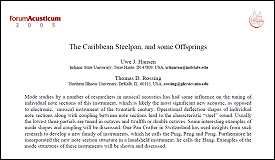Abstract: Mode studies by a number of researchers in musical acoustics has had some influence on the tuning of individual note sections of this instrument, which is likely the most significant new acoustic, as opposed to electronic, musical instrument of the twentieth century. Operational deflection shapes of individual note sections along with coupling between note sections lead to the characteristic “steel” sound. Usually the lowest three partials are tuned in octaves and twelfth or double octaves. Some interesting examples of mode shapes and coupling will be discussed. One Pan Crafter in Switzerland has used insights from such research to develop a new family of instruments, which he calls the Ping, Peng and Pong. Furthermore he incorporated the new note section structure in a hand-held instrument, he calls the Hang. Examples of the mode structures of these instruments will be shown and discussed.
The Caribbean Steelpan, and some Offsprings
Authors: Uwe J. Hansen and Thomas D. Rossing
[http://www.hangblog.org/the-caribbean-steelpan-and-some-offsprings/]


